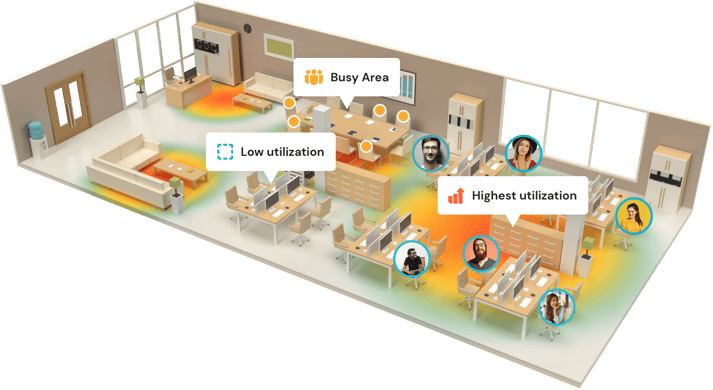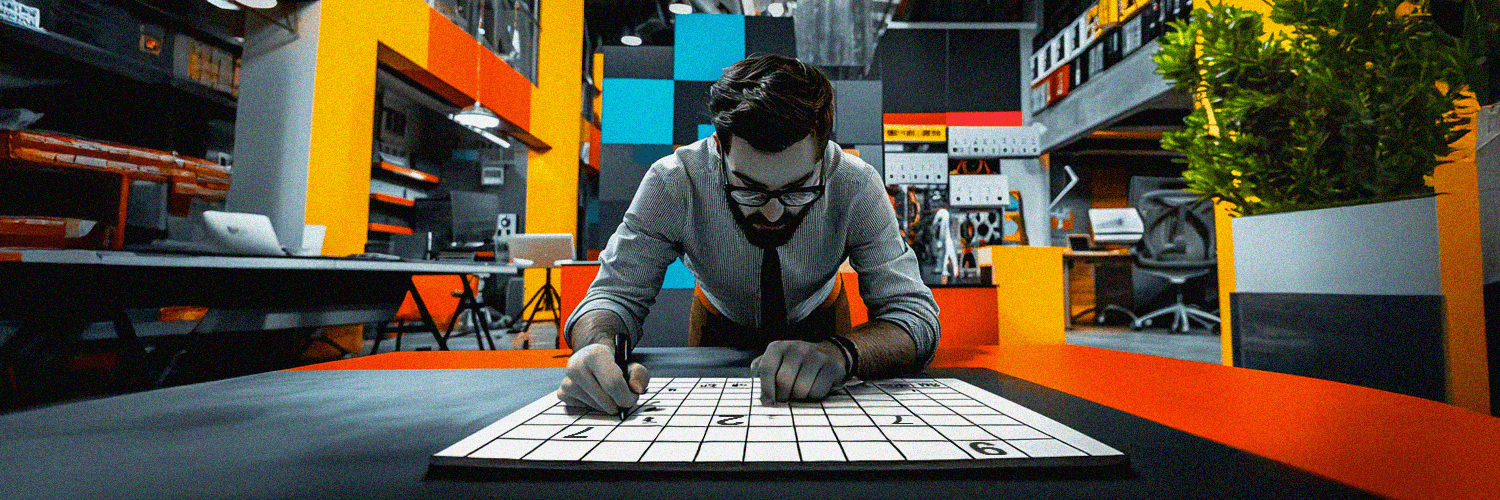Ever felt like you're trying to solve an intricate puzzle, where each piece represents the critical elements of your workspace– occupants, resources, real estate costs, and productivity? That's what occupancy planning feels like. But don't fret over it — we’re here to simplify that puzzle and give you a comprehensive guide on effectively managing it.
This article will journey through critical steps in office occupancy planning, shed light on industry best practices, address challenges, solutions & case studies, and gaze upon future trends--all centered around ensuring an efficient, vibrant workspace that boosts productivity.
TL;DR:
- Occupancy planning is the strategic management of physical workspace utilization to enhance efficiency, collaboration, and employee well-being.
- Effective occupancy planning yields a multitude of benefits for both employees and organizations as a whole.
- Key steps in occupancy planning include gathering data and conducting a workplace assessment, analyzing space utilization and identifying inefficiencies, defining occupancy goals and objectives, developing a strategic plan for space optimization, implementing changes and monitoring results.
- The key to effective occupancy planning is utilizing space utilization analytics, heat mapping, and other proven strategies for effective occupancy planning.
- Other proven strategies for effective occupancy planning include flexible workspace design, technology integration, collaboration and communication, data-driven decision-making, and employee involvement and education.
- The future of occupancy planning includes emerging technologies and trends like IoT, AI, VR/AR, predictions for the evolution of occupancy planning such as a move towards activity-based work settings, increased demand for flexible spaces, and privacy concerns.
What is Office Occupancy Planning?
Occupancy planning in the office environment refers to the strategic management of physical workspace utilization to enhance efficiency, collaboration, and employee well-being. This concept involves analyzing and optimizing the allocation of office space, considering factors such as the number of employees, their departments, and the specific needs of various work activities.
Occupancy planning aims to create an optimal and productive work environment that aligns with organizational objectives. This process includes assessing the spatial requirements of different teams, implementing flexible work arrangements, and leveraging technology to monitor and adjust office space utilization dynamically.
By adopting occupancy planning principles, organizations can not only maximize the utility of their office space but also foster a more adaptable and responsive workplace that accommodates the evolving needs of a modern workforce.
Benefits of Effective Occupancy Planning
When executed effectively, occupancy planning yields a multitude of benefits for both employees and organizations as a whole:
- Optimized Space Utilization: Efficient occupancy planning ensures that office space is used to its full potential. By analyzing usage patterns, companies can eliminate wasted space and create dynamic environments catering to different teams' diverse needs.
- Cost Savings: Streamlining office space boosts productivity and leads to cost savings. Organizations can reduce unused or underutilized areas, energy consumption, and maintenance expenses, contributing to overall financial efficiency.
- Enhanced Collaboration and Communication: Proper occupancy planning facilitates better employee communication and collaboration. Spontaneous interactions increase by strategically placing teams in proximity to one another, fostering creativity and teamwork.
- Flexible Work Environments: In the era of remote work and flexible schedules, effective occupancy planning allows organizations to design spaces that accommodate different work styles. This flexibility enhances employee satisfaction, engagement, and work-life balance.
- Improved Employee Well-being: A well-planned office environment considers employees' well-being. Thoughtful design, access to natural light, ergonomic furniture, and comfortable breakout areas contribute to a positive work atmosphere, increasing job satisfaction and reducing stress levels.
- Adaptability to Change: Occupancy planning allows organizations to quickly adapt to changing business needs. Whether scaling up or down, companies can adjust their office layout and resources efficiently without significant disruptions to daily operations.
- Technology Integration: Modern occupancy planning often involves integrating technology like sensors and data analytics. These tools provide real-time insights into space utilization, allowing organizations to make data-driven decisions for continuous improvement.
- Environmental Sustainability: Optimized office space contributes to workplace sustainability. By reducing unnecessary resource consumption and embracing green design principles, organizations can demonstrate their commitment to corporate social responsibility.
- Enhanced Organizational Productivity: A well-designed office layout, aligned with the needs of different teams, promotes productivity. Employees can focus on tasks without distractions, improving efficiency and overall performance.
- Positive Organizational Culture: A thoughtfully planned office space reflects the values and culture of an organization. It becomes a tangible expression of the company's commitment to employee well-being, collaboration, and innovation, fostering a positive and motivating work environment.
In conclusion, the benefits of effective occupancy planning extend far beyond efficient space utilization. They encompass financial savings, employee satisfaction, adaptability, and creating a workplace that meets functional requirements and promotes a positive organizational culture. As companies continue to recognize the importance of the work environment, the value of strategic occupancy planning becomes increasingly evident in shaping the future of the modern workplace.
-1.png?width=928&height=523&name=Blog%20post%20photos%202%20(3)-1.png)
Key Steps in Occupancy Planning
Let's explore the essential steps for smartly arranging office space to boost productivity and employee happiness.
Gathering Data and Conducting a Workplace Assessment
Imagine this step as creating the rulebook for your occupancy planning strategy. It's about gathering important information about the current workplace – like how much space is available, what employees like, and what facilities are already in place. You're laying a solid foundation by doing thorough assessments and getting to know the day-to-day work.
The critical part is avoiding guesses and making choices based on facts and data. The info you collect now guides all the next steps in occupancy planning. It's like ensuring you have the right chess pieces on the chessboard before you start playing the game.
Analyzing Space Utilization and Identifying Inefficiencies
Now that we've gathered many facts let's jump into analysis mode! This step is like a mirror showing us how well (or not) different office areas are used. It might uncover surprises, like finding meeting rooms that aren't used much or areas where people often feel crowded. The key point is that every inefficiency we spot here is a chance to make things better down the road.
Defining Occupancy Goals and Objectives
Now, let's figure out what we want to achieve with all this. Setting clear goals gives us a roadmap for what we're doing. For example, if noisy areas are making work less productive, a goal could be to create quiet spaces there. In the big picture of flexible workspaces, the goals usually focus on getting the most work done efficiently while ensuring employees feel comfortable and have privacy.
Developing a Strategic Plan for Space Optimization
Now that we've identified challenges and set goals – it's action time! A comprehensive strategic plan maps out the path to achieving our objectives; this could involve redistributing workspace areas, creating new meeting rooms, or even micro-adjustments like changing furniture placement.
Remember: every change should be grounded in data gathered from the initial stages, ensuring a maximum boost in productivity, cost-effectiveness, and overall office space utility.
Implementing Changes and Monitoring Results
Now comes the doing part – putting our plan into action. Whether moving entire departments around or just rearranging a room, it's crucial to make changes without causing too much disruption.
After making changes, we need to keep an eye on things. This post-implementation check helps us see if the changes work as we hoped. And if something needs adjusting, we can tweak it until we find the perfect setup. It's all about making sure our plan works in the real world.
Challenges and Solutions in Occupancy Planning
An effective occupancy planning strategy is not without its challenges. Every stage has its stumbling blocks, from employees' resistance to changing working environments to managing finite resources and budget constraints. Let's delve into these prominent challenges often encountered during occupancy planning and explore some pragmatic approaches.
Overcoming Resistance to Change from Employees
Possibly, one of the largest hurdles faced by companies embarking on changes in workspace utilization is resistance from employees adhering firmly to familiar work routines. These psychological barriers may lead individuals to resist new ways of doing their jobs even when such changes are more efficient or conducive to collaboration.
Solution: A solution lies within good change management practices in place. Prioritize communication at all stages, explaining why changes are being made, the benefits they'll bring, and how they will be implemented. Encourage feedback and provide channels for staff members to voice out their concerns. Also, include training sessions that can help alleviate fears about transition.
Dealing with Limited Resources and Budget Constraints
Budgetary constraints always loom large, especially when considering major workplace modifications potentially required for optimal occupancy planning. Fitting a plan around the available budget while achieving productivity gains can be an arduous balancing act.
Solution: To overcome this challenge, meticulously planned resource allocation becomes mandatory. Focus on understanding the critical elements needed – such as technology platforms or redesign works - then concentrate on justifying these expenditures through projected improvements in efficiency and productivity over time.
Addressing Privacy Concerns in Open Office Environments
The shift towards more flexible workspaces comes with potential pitfalls like personal privacy encroachment due to open-plan office designs that tend to sacrifice individual spaces.
Solution: The key here is finding a balance between openness and privacy based on your team's unique requirements. Consider employing zoning strategies where different areas are allocated for diverse activities, such as quiet zones for focused work and open areas for collaboration. Moreover, integrate elements like sound baffling materials or privacy screens to mitigate noise disruptions and help maintain a semblance of individual space.
The Key to Effective Occupancy Planning: Space Utilization Analytics
One fundamental aspect of effective occupancy planning involves utilizing space utilization analytics. This approach allows you to gather insight into how your workspace is used by giving real-time visibility into various aspects such as room usage, work patterns, etc.
Space utilization analytics provide a data-driven method to identify underused spaces, allowing you to make informed decisions about whether areas should be repurposed or redesigned. For instance, if the data shows that meeting rooms are being underutilized. At the same time, communal areas are often overcrowded, so it might be worth reallocating some space from unused meeting rooms to create additional common areas.

Another insightful method to comprehend space utilization is through heat mapping. Heat mapping involves using sensors or space booking technology such as Yarooms Workplace Experience Platform to track and visualize the concentration and duration of activity within a given space.
Using office heat maps, you can visually represent your workspace's hotspots and coldspots, highlighting areas with high and low traffic. This visual representation enables a more intuitive understanding of how different zones within the office are utilized. For instance, if the heat map reveals that specific workstations are consistently occupied for extended periods while others remain vacant, it can guide decisions on desk allocations and help optimize the layout for improved efficiency. Integrating heat mapping into your space utilization strategy enhances the precision of data-driven insights, offering a holistic perspective on the dynamics of your workspace.
Other Proven Strategies for Effective Occupancy Planning
Occupancy planning is crucial for efficiently utilizing the workspace and ensuring that organizational resources are used optimally. Here are some more proven strategies for effective occupancy planning:
- Flexible Workspace Design:
- Embrace flexible workspace designs that accommodate different work styles and tasks.
- Implement agile and adaptable office layouts that can be easily reconfigured to meet changing needs.
- Consider implementing hot desking or hoteling solutions to allow employees to use available workstations as needed.
- Technology Integration:
- Leverage technology to enhance occupancy planning. Use all-in-one workplace experience platforms to monitor and analyze space utilization in real-time.
- Implement smart building technologies to optimize environmental conditions based on occupancy, promoting energy efficiency.
- Collaboration and Communication:
- Foster open communication and collaboration among different departments to understand their space requirements.
- Regularly engage with employees to gather feedback on the current workspace and identify areas for improvement.
- Encourage collaboration between departments responsible for occupancy planning, such as facilities management, HR, and IT.
- Data-Driven Decision-Making:
- Base occupancy planning decisions on data and analytics rather than assumptions.
- Continuously monitor and analyze occupancy data to identify trends and make informed decisions.
- Use predictive analytics to forecast future space requirements and plan accordingly.
- Employee Involvement and Education:
- Involve employees in the occupancy planning process to understand their needs and preferences.
- Educate employees on the benefits of efficient space utilization and how their cooperation contributes to a more productive and comfortable work environment.
- Promote a culture of responsibility for workspace usage, encouraging employees to use resources efficiently.
Implementing these strategies can lead to more effective occupancy planning, ensuring the workspace is utilized optimally while creating an environment that supports employee productivity and well-being.
The Future of Occupancy Planning
The world of occupancy planning is dynamic, with innovations constantly emerging. Let's explore some notable technologies and trends impacting this field.
Emerging Technologies and Trends in the Field
- Internet of Things (IoT): IoT-enabled devices contribute immensely to occupation planning, from monitoring workspace usage through sensors to automated allocation for optimal utilization.
- Artificial Intelligence (AI): AI-powered predictive analytics can help anticipate workforce needs and refine space optimization strategies.
- Virtual reality (VR) & Augmented Reality (AR): VR & AR platforms enhance workplace design by facilitating realistic virtual walkthroughs before implementation.
While these advancements introduce exciting opportunities for managing office spaces more efficiently, it's imperative to remember that technology is a tool that should be used judiciously. It should improve employee experience without compromising privacy or causing distress due to constant monitoring.
Predictions for the Evolution of Occupancy Planning
As organizations continue evolving their working models, traditional static occupancy planning will give way to a more fluid approach, accommodating hybrid work arrangements. A move towards activity-based work settings might emerge as employees retain partial home-working alongside scheduled office time.
Increased demand for flexible spaces could be another future trend – think coworking spaces and hot-desking systems designed for fluctuating staffing needs. Privacy concerns may usher stricter regulations on data collection, leading planners to find ways for insightful work pattern analysis while adhering to these constraints.
.png?width=928&height=523&name=Blog%20post%20photos%202%20(10).png)
Final Thoughts on the Importance of Effective Occupancy Planning
Occupancy planning isn't just about fitting employees into an office layout; it's about creating conducive environments that enhance productivity and well-being while optimizing resources cost-effectively.
Innovation presently driving this field holds immense promise but is not devoid of challenges like adapting to changing dynamics and ensuring a balance between tech-reliance and human comfort. However, as long as one keeps employee engagement at its core, successfully navigating these evolving waters remains feasible.
To conclude, the future of occupancy planning is here – dynamic, technology-driven, and aware of human needs. It's a thrilling journey towards optimizing workplaces for both functionality and comfort - we hope you're all buckled in!












